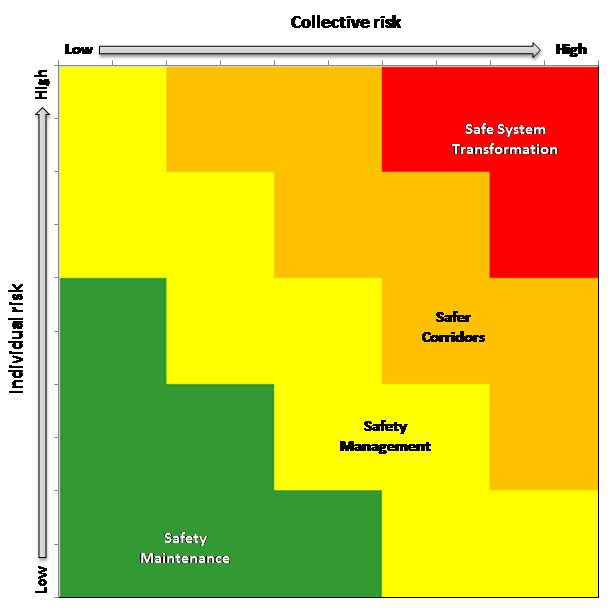
Road Safety Manual
A manual for practitioners and decision makers
on implementing safe system infrastructure!

Road Safety Manual
A manual for practitioners and decision makers
on implementing safe system infrastructure!
Developing network-wide assessments to guide programme development is an essential part of a comprehensive road safety programme for a road authority. This should be based on a good understanding of system-wide risks and issues. Project-level identification of risk that is consistent with the higher level network-focused programme approach is also required. Both are discussed in Assessing Potential Risks and Identifying Issues. In a similar manner, network-level approaches can be taken to address this identified risk through effective infrastructure interventions. To address system wide issues, wide scale implementation of treatments can be undertaken. This implementation can be at the network, corridor, segment or spot location for differing timeframes.
Perhaps the best documented example of this approach is the implementation of the 2+1 road design scheme in Sweden, as described in the case study below.
As well as network-level implementation of specific treatments (such as the 2+1 design identified above), there is also scope to develop frameworks at that provide guidance on application of treatment types. As an example, a framework has been developed in New Zealand for guiding safety investment decisions based on the level of collective and/or individual crash risk. Figure 11.2 below draws on this approach and illustrates how collective and individual risk could be used to influence about cost effective outcomes. Individual risk refers to road safety risk as it applies to any one road user. It is often expressed as the chance of any given road user being involved in a crash (often in crashes per vehicle kilometre travelled, which takes into account traffic volume. Other metrics are also available. Individual risk is a useful measure for assessing the quality (in safety terms) of road infrastructure. Collective risk refers to the total expected crash outcome for all vehicles (e.g. crashes per kilometre), and is heavily influenced by traffic volume. Using information on collective and individual/personal risk the treatment types can be categorised into four groups:

Roads with high traffic volumes have a high expected number of severe crashes; and those that include road engineering features which are substandard for the function, are likely to score highly in both collective and individual risk areas (the red area in Figure 11.2). Substantial investment into road safety treatments on such roads would often be justified via Safe System Transformation works, e.g. a major upgrade; provision of an alternative, higher quality route; freeway style interchanges, etc. Further examples of these higher cost, but highly effective treatments can be found in Effective Safe System Interventions in Intervention Option and Selection.
Roads that experience intermediate collective and individual risk outcomes fall in the Safer Corridors or Safety Management categories (orange and yellow areas in Figure 11.2). For example, highways in rural areas with moderate traffic volumes, some localised and scattered severe crashes, and compromised road design, may fall in the Safe Corridors area. The most effective treatment approach may be via corridor-wide improvements using a mix of high- and low cost solutions (e.g. safety barrier installations, line-marking, intersection upgrades, etc.).
Safety Management ideas may apply to roads with lower traffic volumes, more scattered severe crashes (e.g. local streets and roads) and consistently inadequate road standards. The best economic return on safety would be via network-wide and/or corridor-based application of low cost treatments, e.g. speed limit revisions, line-marking treatments, or targeted asset management (e.g. pavement resurfacing with associated safety treatments, including shoulder sealing). This group also includes roads with high collective severe crash risk due to high traffic volumes, but with a good overall road safety standard (e.g. urban motorways). The most cost-effective actions may be based on targeted systemic changes, e.g. managed freeways techniques and infrastructure supported enforcement.
Roads with low collective and individual risk (green area in Figure 11.2) are most likely candidates for Safety Maintenance activities. Safety Maintenance often involves incremental and systemic changes such as through road management (e.g. skid resistance management), improvements to signs and line-markings, and other good maintenance practices.
Figure 11.2 shows that as collective and individual risk increases, more extensive treatments are likely to be applicable. As risk progresses to higher categories, benefits from applying treatment options from the lower categories should also be considered.
Although developed and implemented in a HIC, the approach outlined is equally useful in LMICs, particularly in the upgrade of existing road infrastructure. The approach may form an effective way of helping to prioritise road safety activity.
The case study from the Czech Republic provides an example of improving safety through the use self-explaining roads.